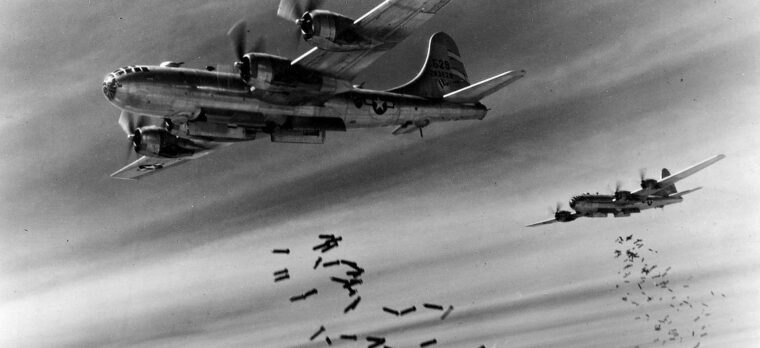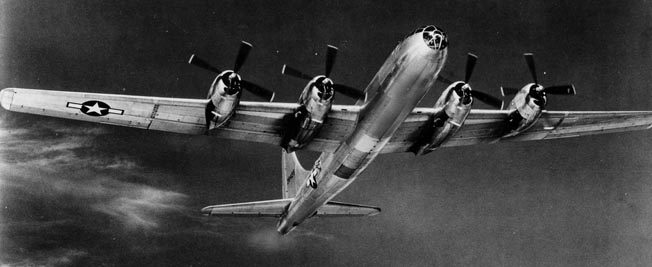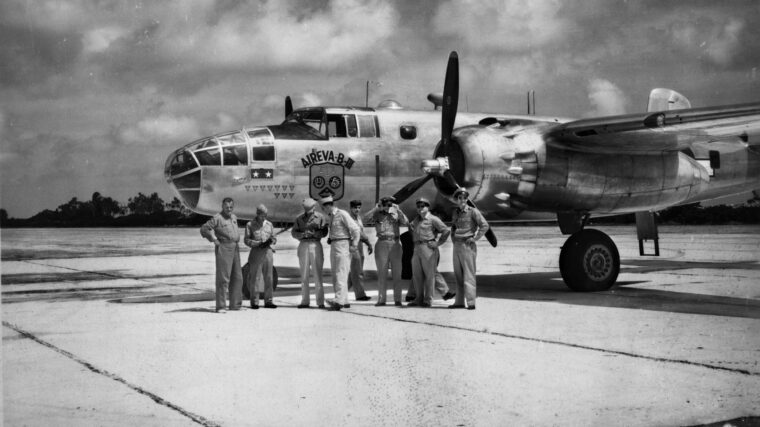
Boeing B-29 Superfortress
Gothas: The German Bombers of World War I
by Jim HavilandOn May 25, 1917, a fleet of 21 bombers lumbered in a line at 12,000 feet over the English coast. Read more

Boeing B-29 Superfortress
On May 25, 1917, a fleet of 21 bombers lumbered in a line at 12,000 feet over the English coast. Read more

Boeing B-29 Superfortress
Most writings about World War II tend to attribute the success or failure of military operations to the skill with which generals and admirals handled their forces in battle and to the fighting abilities of soldiers, sailors, and airmen. Read more

Boeing B-29 Superfortress
On June 10, 1944, as his troop transport churned through the Pacific toward the Japanese-held island of Saipan, Pharmacist’s Mate First Class Stan Bowen wrote a letter to his sweetheart, Marge McCann. Read more

Boeing B-29 Superfortress
As the Japanese delegation stood on the deck of the battleship USS Missouri on September 2, 1945, preparing to sign the documents that ended World War II, a large formation of Boeing B-29 Superfortress heavy bombers swooped low over Tokyo Bay as a reminder of the terrible destruction that had befallen their nation and turned Japan’s cities into ruins. Read more

Boeing B-29 Superfortress
On Saturday, May 5, 1945, three days before the end of World War II in Europe and just three months before the Japanese surrendered, spinning shards of metal ripped into the tall pine trees, burrowing holes into bark and tearing needles from branches outside the tiny logging community of Bly, Oregon. Read more

Boeing B-29 Superfortress
The most controversial decision of the 20th century—probably in all of history—was the one reportedly made by President Harry S. Read more

Boeing B-29 Superfortress
The iconic image of a woman in overalls, her hair tied up in a bandana, and flexing her bicep below the headline, “We Can Do It,” is one of the most recognizable images from World War II. Read more

Boeing B-29 Superfortress
The Boeing B-29 Superfortress was a game changer. First rolling off the assembly line as a production aircraft in July 1943, the Superfortress was the answer to America’s need for a high-level long-range strategic bomber. Read more

Boeing B-29 Superfortress
By Joe Kirby
When Maj. Gen. Curtis LeMay, the hard-driving commander of the Twentieth U.S. Air Force based in Guam, decided to change tactics in early 1945 to boost the effectiveness of the B-29 Superfortress, it was the Bell Aircraft plant in Marietta, Georgia, that ultimately provided him with the stripped-down bombers that played such a key role in ending the war in the Pacific. Read more

Boeing B-29 Superfortress
Major Sam P. Bakshas woke up that morning with the secrets in his head. He was one of the men flying B-29 Superfortress bombers from three Pacific islands—Guam, Saipan, and Tinian. Read more

Boeing B-29 Superfortress
Wright-Patterson Air Force Base in Dayton, Ohio, is home to the National Museum of the United States Air Force––the oldest and largest aviation museum in the world. Read more

Boeing B-29 Superfortress
At the start of World War II, Japanese airpower ruled the skies over China and the Pacific. Read more

Boeing B-29 Superfortress
From an altitude of 30,000 feet, the swift Japanese reconnaissance aircraft flew high over Saipan and Tinian, photographing the brisk and extensive engineering effort under way on the American airfields far below. Read more

Boeing B-29 Superfortress
One of the most frequently discussed arguments to come out of World War II is which was the “better” bomber, the Boeing B-17 Flying Fortress or the Consolidated B-24 Liberator? Read more

Boeing B-29 Superfortress
The Marines were tired, eager for a rest and the opportunity to get themselves and their equipment back into battle condition. Read more

Boeing B-29 Superfortress
At the beginning of World War II, the globe seemed huge—covered by thousands of miles of ocean and uninhabited land mass, but by the time it ended everything had been brought closer together, thanks largely to the four-engine transports of the United States Army Air Transport Command, particularly the Douglas C-54 Skymaster. Read more

Boeing B-29 Superfortress
Lieutenant Harold Gilson Payne, Jr., was one of the first Americans to die at Iwo Jima. He did not fall in the carnage of the Marine invasion that began on February 19, 1945. Read more

Boeing B-29 Superfortress
In 1942, many Americans considered anyone of Japanese ancestry to be an enemy, regardless of where they had been born or how long their families had lived in the United States. Read more

Boeing B-29 Superfortress
Stephen Pierce Duggan, Jr., wanted to be a United States Marine. When the United States entered World War II, Steve was all set to do his part. Read more

Boeing B-29 Superfortress
Jimmy Stewart is arguably the only prewar American actor of superstar magnitude to have served in a sustained combat role during World War II, and the only one to have served in a position of command. Read more